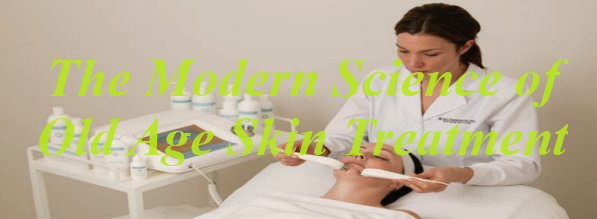The Modern Science of Old Age Skin Treatment

The Modern Science of Old Age Skin Treatment
Only in the past few years have researchers understood more about photo damage and discovered methods of effective treatment for photoaging.
Although prevention and daily use of broad-spectrum sunscreens are still the best treatment, aestheticians now have at their disposal new and promising techniques and ingredients to help reduce the aesthetic effects of photodamage and to help protect and maintain healthy skin.
Recently, more and more is being learned about DNA repair and also ingredients like resveratrol, which may give us some control over genetics-related intrinsic appearance signs of aging skin.
Learning to stimulate collagen production helps both signs of sun damage and signs of aging due to hormonal factors affecting collagen production.
This means we soon may have ways of treating extrinsic damage as well as some factors in intrinsic aging.
Although the aesthetician primarily treats the appearance of the skin, there is mounting scientific evidence that many of the new techniques and ingredients likely have a positive effect on skin health as well as on sun damage prevention.
Treatment of photoaging skin
Prevention (No Sun)
Daily use of broad-spectrum sunscreen is the first step in photo-damage treatment.
Even if the skin is already severely sun damaged, daily application of sunscreen prevents more damage and gives the skin a better chance to produce good effects from other topical treatments.
Using sunscreen on a daily basis cannot be emphasized enough.
Many clients erroneously worry only about sunburn.
They think sun damage occurs only through visible sunburn and irritation.
They are often likely to apply sunscreen only when they know they will be exposed to direct sunlight for several hours.
The truth is that most of our sun damage occurs through day-to-day exposure.
Driving to work, going to the mailbox, playing with our children, and taking a walk are examples of everyday sun exposure that becomes cumulative.
Even sitting by a window exposes us to deep-penetrating (and aging) UVA rays, which go right through the glass.
This is why it is so important that aestheticians help clients by advising the daily use of good sunscreen.
Remember that broad-spectrum sunscreens are important to shield the skin from UVA and UVB rays.
Look for active ingredient lists containing ingredients that protect against both forms of UV light.
Effective combinations include octinoxate with titanium dioxide or zinc oxide or combinations of absorbing octinoxate, oxybenzone, avobenzone, ecamsule, and octisalate.
In most cases, clients can wear a day cream with built-in sunscreen.
Most scientists and dermatologists recommend a sun protection factor (SPF) of 15 or higher with broad-spectrum protection.
It is usually not necessary to wear a separate moisturizer cream, except in extremely dry skin or extremely cold, dry climates.
Good day sunscreens are now available in a variety of weights and in lotion, gel, or cream forms, so they can be selected for the right skin type.
Many sunscreens contain hydrators like glycerin or hyaluronic acid, soothing ingredients like green tea extract, and other conditioners for specific skin types.
Having this variety of daily-use sunscreens available helps with client compliance in using sunscreen every day.
Clients will use a product that is comfortable and meets their individual needs, such as a lightweight product, a product that works well under makeup, or one that is also a moisturizer.
The client’s first visit should include a thorough discussion about the harmful effects of the sun.
This author recommends a no-holds-barred lecture (in a friendly way!) about the ravages of cumulative sun damage.
Emphasis should be placed on the cumulative nature of sun damage.
Many clients will say, “I haven’t had any sun in months!”
The truth is that most of the sun damage aestheticians see is from sunbathing that occurred 20 years ago and through years of daily exposure.
Unless the client follows good sun habits or better yet, stays out of the sun altogether improvement will be at best minimal.
The first need of sun-damaged skin is to remove the source of damage.
Exfoliation
The cell “turnover rate” slows down with aging anyway, but the rate is even slower in sun-damaged skin.
Not only is the rate often slower, the cells are disorganized and are not in even layers.
You must remember that sun damage causes abnormal cell growth and generally disorganizes normal cell patterns.
This, of course, also affects the epidermis, piling dead cells on top of the skin in uneven patterns as they accumulate.
Microscopic cross-section photographs of sun-damaged skin show severe disfigurations of the normal growth patterns of the strata of the epidermis.
This can be both a medical and a cosmetic concern.
Dysplastic cell growth can eventually cause skin cancer but aesthetically causes a rough, dry, scaly appearance on the skin’s surface and contributes to the appearance of wrinkles.
Since intercellular lipids are produced by the skin during the cell renewal (keratinization) process, as the cell renewal rate slows, so does the production of intercellular lipids.
This reduction in lipid production interferes with barrier function and reduces the ability of the skin to hold essential moisture.
Clients who have this type of sun-damaged skin have a great deal of difficulty keeping their skin moisturized.
Hydrators attract water to the skin, but there is not enough lipid to bind the moisture.
Daily use of an alpha hydroxy serum or cream increases the speed of cell renewal, improves lipid production, and removes excess accumulations of dead cell buildup from the skin surface.
By removing this conglomeration of dry, dead cells, the surface of the skin appears much smoother, and wrinkles appear less deep.
Hydrators applied over the alpha hydroxy treatments perform better because they do not have to moisturize the dead-cell buildup.
Instead, they work to hydrate the skin more evenly, which makes the skin appear much smoother.
Imagine a thick layer of cells lying on top of the skin.
These cells are all dried up, like a thick layer of dust lying on top of a piece of furniture.
This cell buildup makes the skin’s surface look dull and flat, just as dust prevents light from reflecting a piece of furniture.
Surface mechanical exfoliation, which we have already discussed, helps to remove some of the “dust.”
Alpha hydroxy acids, however, work by loosening the “glue” of lipids that hold the cells together, helping to continually shed off this sheath of cells.
This removal of dead cells is also beneficial to acne-prone skin, helping to loosen both surface cell buildup and impacted dead cells inside the follicle, which, as previously discussed, can lead to comedones and possibly to acne.
The use of a daily chemical exfoliant helps rid skin of thick epidermal corneum that makes skin look dull.
Cell buildup can make wrinkles look worse, dryness more uncomfortable, and splotchiness and hyperpigmentation more apparent.
Daily use of alpha hydroxy and/or beta hydroxy acid treatment products can significantly improve skin texture, colour evenness, depth of surface wrinkles, and smoothness.
More importantly, regular use of AHAs helps “re-layer” the epidermal cells, which improves barrier function, hydration, and intercellular lipid production.
All of these changes not only help the appearance but also result in healthier skin.
Using chemical exfoliants like AHAs, BHAs, or retinoids makes the daily use of broad-spectrum sunscreen even more important.
Because the corneum is thinner in these skin types, the skin is more sun sensitive.
Retinoids
The first real science that showed that topical agents could be used to improve photo-damaged skin was performed in the 1980s.
Women who had been using the prescription drug Retin-A for their acne noticed that their wrinkles were less noticeable and that their treated skin looked smoother.
Studies of this drug followed for the treatment of photoaging skin.
Retinoids are vitamin A–based chemicals that include prescription tretinoin or retinoic acid, better known as Retin-A or Renova, and tazarotene, a chemical cousin of vitamin A, commercially known as Tazorac.
These prescription drug chemicals have been shown to reduce wrinkles, roughness, solar freckles, and hyperpigmentation and generally improve the skin’s appearance.
Renova, a more moisturizing version of tretinoin, is the first prescription drug ever approved to treat the symptoms of sun damage.
Histologically, tretinoin has been shown to “reorganize” the skin, reestablishing a more normal epidermis, increasing blood vessel formation, increasing collagen production, and generally improving the damaged skin.
With these positive changes, there are some side effects including;
- redness,
- irritation,
- flaking,
- dryness,
- and severe dehydration.
Sun exposure should be avoided because the drug makes the skin more sun sensitive.
A broad-spectrum sunscreen, as with any skin, is even more important for the patient.
Nonprescription retinoids used in skin care products include retinol and retinyl palmitate, which are other forms of vitamin A.
These are good antioxidant ingredients, but they do not work by the same mechanism or show the same results as tretinoin.
Retinol, combined or used with alpha hydroxy acid, has been shown to improve sun-damaged skin.
Alpha Hydroxy Acids
Alpha hydroxy acid treatment is probably the most effective tool that the aesthetician has to treat the photoaging skin.
We have already discussed how alpha hydroxy acids affect the skin.
Alpha hydroxy as well as beta hydroxy acids have a remarkable effect on photoaging.
They are an integral part of any program for treating photoaged skin.
The terms alpha hydroxy acid and glycolic acid are often used interchangeably.
However, technically, glycolic acid is an alpha hydroxy acid, and treatments may involve both alpha hydroxy and beta hydroxy acids.
Alpha hydroxy acids include;
- glycolic acid,
- lactic acid,
- tartaric acid,
- and malic acid.
These functional agents can be used in products as individual acids or in special AHA blends.
Although very different from retinoids, these agents also help “reorganize” the epidermis.
Regular use of an 8 to 10 percent alpha hydroxy treatment product with a pH of no less than 3.5 can
- reduce wrinkles,
- smooth the skin surface,
- reduce uneven colouring,
- and improve hydration and firmness.
Cell renewal triggers increased intercellular lipid synthesis, resulting in improved barrier function, thus improving hydration and reducing sensitivity.
Long-term use results in increased collagen deposition.
Again, these changes occur with regular, daily applications as described earlier.
They do not occur with periodic use or an occasional salon AHA treatment appearance without home-care AHA use.
Rules for the use of Retinoid
- Tretinoin, adapalene, tazarotene, and other prescribed retinoids are prescription drugs. The client must follow the advice of the dermatologist regarding usage procedures.
- Cosmetic and skin care product usage may be affected by the use of retinoids. Clients may find they are more sensitive to products that they normally and routinely use. The aesthetician needs to help guide the client to choose products that can be used with retinoids.
- Facial treatments may need to be adapted for the patient using a retinoid. This includes discontinuing the use of any chemical or mechanical exfoliation treatment; using gentle, fragrance-free hydrators; and avoiding heat and any alcoholic or stimulating skin care products.
- Redness and peeling can be normal transitional side effects, particularly when first using a prescription retinoid. These side effects can be minimized by using good hydrators and being careful with the amount and frequency of application of the retinoid. Some patients find it helpful to “phase in” retinoids, using the retinoid every second or third night and slowly switching to every night.
- Sun should be completely avoided when using retinoids. Deliberate sun exposure is contraindicated and is counterproductive to any therapy for the improvement of photo-damaged skin.
- Scented and fragranced products, alcohol-based lotions, stripping products, abrasive scrubs, microdermabrasion, alpha hydroxy or beta hydroxy acid products, benzoyl peroxide, sulphur-resorcinol, and other exfoliating agents should be avoided on clients using retinoids.
- Do not wax clients using retinoids! Electrolysis is usually acceptable after the transitional side effects have passed.
Besides typical aging and wrinkles, alpha hydroxy acids can help improve hand and foot calluses, general dry and dehydrated skin, and dry body skin.
Stimulation
The circulation of sun-damaged skin is impaired by the malformation of blood vessels due to sun damage.
Therefore, the skin is not nourished properly through normal blood flow.
The use of good but gentle massage techniques is helpful in improving circulation.
Massage also improves hydration and stimulates better product absorption.
Be careful when massaging skin that is being treated with a strong keratolytic such as Retin-A or other retinoids.
This skin can be treated with massage, but be careful not to overstimulate.
Microdermabrasion
Microdermabrasion is a technique using small crystals, usually aluminium oxide, to exfoliate the skin mechanically.
A microdermabrasion machine uses pressure to spray the crystals onto the skin surface, physically removing dead cells from the stratum corneum.
Some companies also sell crystals in creams that can be applied with the hands.
Microdermabrasion is an alternate technique to forms of chemical exfoliation.
Chemical and mechanical exfoliation should not be combined, because the combination can over-exfoliate the skin and damage its barrier function if overused.
Because microdermabrasion is mechanical, and its frequency of application, pressure of application, and number of passes (how many times the technique is applied to a certain area of skin) can vary with the aesthetician’s judgment, it can easily be overdone.
Be very careful in assessing the skin sensitivity and thickness of the individual client before choosing the correct exfoliation technique.
Antioxidant Therapy
There is growing evidence that the use of topical antioxidants reduces the visible signs of aging, helps prevent damage due to reactive oxygen species (free radicals), and makes the skin behave in a better way.
Skin science researchers now know that antioxidants seem to work better when several different antioxidants are combined.
We know that not all antioxidants work to squelch reactions at all levels of the inflammation cascade of chemical reactions.
These combinations of antioxidants are referred to as broad-spectrum antioxidants.
There are many types of antioxidants, including vitamins like;
- vitamin C as L-ascorbic acid magnesium ascorbyl phosphate (the ester form of vitamin C),
- and vitamin E as tocopherol and tocopheryl acetate.
Plant extract antioxidants include;
- green tea,
- white tea,
- and grapeseed extract (known to be 50 times as strong an antioxidant as vitamin C).
Superoxide dismutase is an enzyme that helps squelch early reactions in the cascade of reactions.
Some of the “newest” powerful antioxidant ingredients include
- lichochalcone,
- resveratrol,
- alpha lipoic acid,
- idebenone,
- coffeeberry,
- and stearyl glycyrrhizinate (derived from licorice).
Antioxidants are believed to work by interfering with or stopping reactions within the inflammation cascade, reducing inflammation and production of damaging enzymes that can injure or destroy the collagen and elastin fibrils that keep the skin smooth and elastic.
There is growing evidence and scientific acceptance that antioxidants are helpful in preventing skin damage and in the treatment of photo-damaged skin.
It is not enough simply to include these ingredients in a treatment product.
The antioxidants must stay stable until they are used on the skin, and they must be delivered properly to where they are needed.
Most antioxidants are unstable and must be formulated correctly so they are protected from oxidation.
One sign that an antioxidant has been oxidized is that the product turns brown quickly when exposed to air, specifically oxygen.
Microencapsulated delivery systems such as liposomes provide good protection for the antioxidants.
The lipid-based encapsulation protects the antioxidants from oxidation, and the lipid “shells” are readily accepted by the intercellular cement that comprises the barrier function, thus helping them penetrate more easily into the epidermal layers.
Powerful broad-spectrum antioxidant complexes are often manufactured in serum form and should be applied before an alpha hydroxy acid treatment product, sunscreen, or hydrator.
Peptides
Peptides are chains of amino acids that biochemically communicate with the skin, causing changes in behaviour that result in improvement in the appearance of various aesthetic skin conditions.
Some of the peptides used in the treatment of aging and photoaging skin are as follows:
- Palmitoyl pentapeptide-4, also known as Matrixyl, was the first peptide to be widely used in products for aging skin. It stimulates collagen and reduces the production of collagenase, the enzyme that breaks down collagen in photoaging skin.
- Palmitoyl oligopeptide and palmitoyl tetrapeptide-7, also known as Matrixyl–3000 (an updated complex), are a combination of two different peptides that together stimulate collagen, fibronectin, and hyaluronic acid content in the skin. Palmitoyl tetrapeptide-7 also has soothing properties.
- Acetyl hexapeptide-8, also known as Argireline, is known as the wrinkle-relaxing peptide. This peptide works to soften expression lines and is helpful in clients who have multiple wrinkles. It works well when used with alpha hydroxy serums, which together help reduce wrinkle depth as well as relax wrinkle tension. It can also be used in conjunction with the palmitoyl peptides discussed earlier.
- Acetyl Dipeptide-2 is used in eye creams to help reduce puffiness. Eye creams containing this peptide also often contain collagen stimulant peptides and often flavonoids like hesperidin methyl chalcone and chrysin that help fade the appearance of dark circles under the eyes.
Peptides are easily combined with other ingredients and can be used in moisturizers, serums, and eye creams.
They also rarely cause any inflammation or reactions.
When used with sunscreens, AHA products, and antioxidants, they produce excellent results in making photoaging skin look smoother, more elastic, and younger.
Use of Lipid Products and Hydrators.
Hydration is very important in improving the appearance of photo-damaged skin.
Sun damage results in the skin losing its ability to hold water.
Lipid ingredients, as previously discussed, are helpful in “patching” the “mortar” between the cells, helping to boost hydration, firmness, and smoothness and reduce inflammation potential.
These lipids include;
- phospholipids,
- sphingolipids or glycol-sphingolipids (also known as ceramides),
- cholesterol,
- and fatty acids.
These lipid complexes can be included in sunscreens, hydrators, specialty creams, masks, or serums.
They are especially effective as a treatment for dry, alipidic, or extremely dry skin.
The lipids work by helping to hold essential hydration in the epidermis.
They should be used with a hydrator to attract water to the skin.
Hydration ingredients include;
- butylene glycol,
- hyaluronic acid or sodium hyaluronate,
- glycerin,
- sodium PCA,
- or sorbitol.
These ingredients are also blended into the same products for sun-damaged skin as mentioned earlier.
Be careful to remember the skin type when you are choosing a hydrator or other cream.
Aging oily or combination skin can become impacted and comedonal from exposure to too many fatty emollients.
Gels, liquids, and lotions that are specially designed for oily or acne-prone oily skin should be recommended.
Avoidance of Irritation
The symptoms of what we think of as aging are an accumulation of damage to skin tissue caused by chronic irritations, such as sun exposure.
All clients should avoid irritating the skin at any age, especially in already photo-damaged skin.
A Typical Home-Care Program for Photoaging Skin
Clients with photoaging skin should have the entire skin care program explained to them in detail.
It is important that they understand the function of all products prescribed and why each is important in the success of their program.
It should be emphasized that for the program to succeed, the client must be diligent about home-care use.
Provide them with a step-by-step home-care instruction sheet to follow, and use it to describe each step during the consultation.








